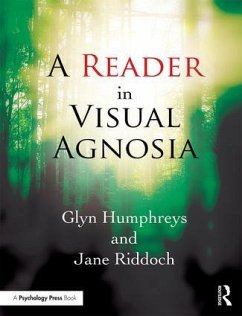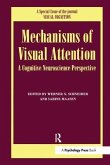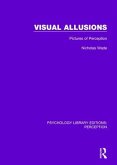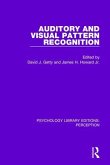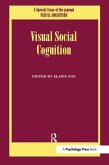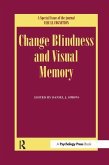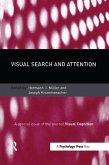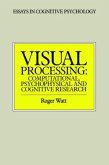- Broschiertes Buch
- Merkliste
- Auf die Merkliste
- Bewerten Bewerten
- Teilen
- Produkt teilen
- Produkterinnerung
- Produkterinnerung
This Reader accompanies the ground-breaking books To See But Not To See (1987) and A Case Study in Visual Agnosia Revisited (2013) by reproducing the primary scientific papers published on the famous case study of John, who acquired visual agnosia following a stroke. It will be invaluable to students and researchers in visual cognition, cognitive neuropsychology and vision neuroscience.
Andere Kunden interessierten sich auch für
![Mechanisms Of Visual Attention Mechanisms Of Visual Attention]() Sabine Maasen / Werner X. Schneider (eds.)Mechanisms Of Visual Attention173,99 €
Sabine Maasen / Werner X. Schneider (eds.)Mechanisms Of Visual Attention173,99 €![Visual Allusions Visual Allusions]() Nicholas WadeVisual Allusions51,99 €
Nicholas WadeVisual Allusions51,99 €![Auditory and Visual Pattern Recognition Auditory and Visual Pattern Recognition]() Auditory and Visual Pattern Recognition47,99 €
Auditory and Visual Pattern Recognition47,99 €![Visual Social Cognition Visual Social Cognition]() Visual Social Cognition58,99 €
Visual Social Cognition58,99 €![Change Blindness and Visual Memory Change Blindness and Visual Memory]() Change Blindness and Visual Memory67,99 €
Change Blindness and Visual Memory67,99 €![Visual Search and Attention Visual Search and Attention]() Visual Search and Attention48,99 €
Visual Search and Attention48,99 €![Visual Processing Visual Processing]() Roger WattVisual Processing58,99 €
Roger WattVisual Processing58,99 €-
-
-
This Reader accompanies the ground-breaking books To See But Not To See (1987) and A Case Study in Visual Agnosia Revisited (2013) by reproducing the primary scientific papers published on the famous case study of John, who acquired visual agnosia following a stroke. It will be invaluable to students and researchers in visual cognition, cognitive neuropsychology and vision neuroscience.
Produktdetails
- Produktdetails
- Verlag: Routledge
- Seitenzahl: 408
- Erscheinungstermin: 27. Februar 2018
- Englisch
- Abmessung: 246mm x 189mm x 22mm
- Gewicht: 786g
- ISBN-13: 9781138121232
- ISBN-10: 1138121231
- Artikelnr.: 57064468
- Herstellerkennzeichnung
- Libri GmbH
- Europaallee 1
- 36244 Bad Hersfeld
- gpsr@libri.de
- Verlag: Routledge
- Seitenzahl: 408
- Erscheinungstermin: 27. Februar 2018
- Englisch
- Abmessung: 246mm x 189mm x 22mm
- Gewicht: 786g
- ISBN-13: 9781138121232
- ISBN-10: 1138121231
- Artikelnr.: 57064468
- Herstellerkennzeichnung
- Libri GmbH
- Europaallee 1
- 36244 Bad Hersfeld
- gpsr@libri.de
Glyn Humphreys is Watts Professor of Experimental Psychology at the University of Oxford, UK. His research covers the diagnosis and management of cognitive problems after brain injury, visual attention, perception, language and the control of action, and social cognition. He has published over 500 papers in international journals and 16 books. Jane Riddoch is Professorial Research Fellow at the University of Oxford, UK. Her research covers visual disorders (agnosia, optic aphasia), disorders of attention (neglect, extinction), and action (apraxia, action disorganisation syndrome) and neuropsychological rehabilitation. She has published 150 papers in leading international journals and authored/edited five books.
Part 1: Integrative visual agnosia 1. A case of integrative visual agnosia. (1987)
Riddoch
M.J. & Humphreys
G.W. 2. The computation of occluded contours in visual agnosia: Evidence for early computation prior to shape binding and figure-ground coding. (2000)
Giersch
A.
Humphreys
G.W.
Boucart
M. & Kovacs
I. 3. A two-stage account of computing and binding occluded and visible contours: Evidence from visual agnosia and effects of lorazepam. (2006)
Giersch
A.
Humphreys
G.W.
Barthaud
J.C. & Landmanbn
C. 4. The necessary role of the dorsal visual route in the heterarchical coding of global visual pattern: Evidence from neuropsychological fMRI. (2014)
Lestou
V.
Kourtzi
Z.
Humphreys
K.L.
Lam
J. & Humphreys
G.W. 5. Parallel pattern processing in visual agnosia. (1992)
Humphreys
G.W.
Riddoch
M.J.
Quinlan
P.T.
Price
C.J. & Donnelly
N. Part 2: Seeing the whole 6. The computation of perceptual structure from collinearity and closure: Normality and pathology. (1992)
Boucart
M. & Humphreys
G.W. 7. Ventral extra-striate cortical areas are required for optimal orientation averaging. (2007)
Allen
H.A.
Humphreys
G.W. & Bridge
H. 8. Interactive processes in perceptual organization: Evidence from visual agnosia. (1985)
Humphreys
G.W.
Riddoch
M.J. & Quinlan
P.T. 9. A tale of two agnosias: Distinctions between form and integrative agnosia. (2008)
Riddoch
M.J.
Humphreys
G.W.
Akthar
N.
Bracewell
R.M & Schofield
A.J. 10. The effects of view in depth on the identification of line drawings and silhouettes of familiar objects: Normality and pathology. (1999)
Lawson
R. & Humphreys
G.W. 11. The real object advantage in agnosia: Evidence of a role for shading and depth in object recognition. (2001)
Chainay
H. & Humphreys
G.W. Part 3: What's in a face? 12. Expression is computed separately from facial identity
and it is computed separately for moving and static faces: Neuropsychological evidence. (1993)
Humphreys
G.W.
Donnelly
N. & Riddoch
M.J. 13. Exploring the role of motion in prosopagnosia: Recognizing
learning and matching faces. (2004)
Lander
K.
Humphreys
G.W. & Bruce
V. 14. Recognition impairments and face imagery. (1994)
Young
A.W.
Humphreys
G.W.
Riddoch
M.J.
Hellalwell
D.J. & de Haan
E.H.F. Part 4: Colour
movement
action! 15. Human colour discrimination based on a non-parvocellular pathway. (1996)
Troscianko
T.
Davidoff
J.
Humphreys
G.W.
Landis
T.
Fahle
M.
Greenlee
M.
Brugger
P. & Phillips
W. 16. The neural representation of objects in space: A dual coding account. (1998)
Humphreys
G.W. 17. Visual and spatial short-term memory in visual agnosia. (2003)
Riddoch
M.J.
Humphreys
G.W.
Hardy
E.
Blott
W. & Smith
A. Part 5: The written word 18. The 'special effect' of case mixing on word identification: Neuropsychological and TMS studies dissociating case mixing from contrast reduction. (2006)
Braet
W. & Humphreys
G.W. Part 6: Living with agnosia 19. Memories are made of this: The effects of time on stored visual knowledge in a case of visual agnosia. (1999)
Riddoch
M.J.
Humphreys
G.W.
Gannon
T.
Blott
W. & Jones
V.
Riddoch
M.J. & Humphreys
G.W. 2. The computation of occluded contours in visual agnosia: Evidence for early computation prior to shape binding and figure-ground coding. (2000)
Giersch
A.
Humphreys
G.W.
Boucart
M. & Kovacs
I. 3. A two-stage account of computing and binding occluded and visible contours: Evidence from visual agnosia and effects of lorazepam. (2006)
Giersch
A.
Humphreys
G.W.
Barthaud
J.C. & Landmanbn
C. 4. The necessary role of the dorsal visual route in the heterarchical coding of global visual pattern: Evidence from neuropsychological fMRI. (2014)
Lestou
V.
Kourtzi
Z.
Humphreys
K.L.
Lam
J. & Humphreys
G.W. 5. Parallel pattern processing in visual agnosia. (1992)
Humphreys
G.W.
Riddoch
M.J.
Quinlan
P.T.
Price
C.J. & Donnelly
N. Part 2: Seeing the whole 6. The computation of perceptual structure from collinearity and closure: Normality and pathology. (1992)
Boucart
M. & Humphreys
G.W. 7. Ventral extra-striate cortical areas are required for optimal orientation averaging. (2007)
Allen
H.A.
Humphreys
G.W. & Bridge
H. 8. Interactive processes in perceptual organization: Evidence from visual agnosia. (1985)
Humphreys
G.W.
Riddoch
M.J. & Quinlan
P.T. 9. A tale of two agnosias: Distinctions between form and integrative agnosia. (2008)
Riddoch
M.J.
Humphreys
G.W.
Akthar
N.
Bracewell
R.M & Schofield
A.J. 10. The effects of view in depth on the identification of line drawings and silhouettes of familiar objects: Normality and pathology. (1999)
Lawson
R. & Humphreys
G.W. 11. The real object advantage in agnosia: Evidence of a role for shading and depth in object recognition. (2001)
Chainay
H. & Humphreys
G.W. Part 3: What's in a face? 12. Expression is computed separately from facial identity
and it is computed separately for moving and static faces: Neuropsychological evidence. (1993)
Humphreys
G.W.
Donnelly
N. & Riddoch
M.J. 13. Exploring the role of motion in prosopagnosia: Recognizing
learning and matching faces. (2004)
Lander
K.
Humphreys
G.W. & Bruce
V. 14. Recognition impairments and face imagery. (1994)
Young
A.W.
Humphreys
G.W.
Riddoch
M.J.
Hellalwell
D.J. & de Haan
E.H.F. Part 4: Colour
movement
action! 15. Human colour discrimination based on a non-parvocellular pathway. (1996)
Troscianko
T.
Davidoff
J.
Humphreys
G.W.
Landis
T.
Fahle
M.
Greenlee
M.
Brugger
P. & Phillips
W. 16. The neural representation of objects in space: A dual coding account. (1998)
Humphreys
G.W. 17. Visual and spatial short-term memory in visual agnosia. (2003)
Riddoch
M.J.
Humphreys
G.W.
Hardy
E.
Blott
W. & Smith
A. Part 5: The written word 18. The 'special effect' of case mixing on word identification: Neuropsychological and TMS studies dissociating case mixing from contrast reduction. (2006)
Braet
W. & Humphreys
G.W. Part 6: Living with agnosia 19. Memories are made of this: The effects of time on stored visual knowledge in a case of visual agnosia. (1999)
Riddoch
M.J.
Humphreys
G.W.
Gannon
T.
Blott
W. & Jones
V.
Part 1: Integrative visual agnosia 1. A case of integrative visual agnosia. (1987)
Riddoch
M.J. & Humphreys
G.W. 2. The computation of occluded contours in visual agnosia: Evidence for early computation prior to shape binding and figure-ground coding. (2000)
Giersch
A.
Humphreys
G.W.
Boucart
M. & Kovacs
I. 3. A two-stage account of computing and binding occluded and visible contours: Evidence from visual agnosia and effects of lorazepam. (2006)
Giersch
A.
Humphreys
G.W.
Barthaud
J.C. & Landmanbn
C. 4. The necessary role of the dorsal visual route in the heterarchical coding of global visual pattern: Evidence from neuropsychological fMRI. (2014)
Lestou
V.
Kourtzi
Z.
Humphreys
K.L.
Lam
J. & Humphreys
G.W. 5. Parallel pattern processing in visual agnosia. (1992)
Humphreys
G.W.
Riddoch
M.J.
Quinlan
P.T.
Price
C.J. & Donnelly
N. Part 2: Seeing the whole 6. The computation of perceptual structure from collinearity and closure: Normality and pathology. (1992)
Boucart
M. & Humphreys
G.W. 7. Ventral extra-striate cortical areas are required for optimal orientation averaging. (2007)
Allen
H.A.
Humphreys
G.W. & Bridge
H. 8. Interactive processes in perceptual organization: Evidence from visual agnosia. (1985)
Humphreys
G.W.
Riddoch
M.J. & Quinlan
P.T. 9. A tale of two agnosias: Distinctions between form and integrative agnosia. (2008)
Riddoch
M.J.
Humphreys
G.W.
Akthar
N.
Bracewell
R.M & Schofield
A.J. 10. The effects of view in depth on the identification of line drawings and silhouettes of familiar objects: Normality and pathology. (1999)
Lawson
R. & Humphreys
G.W. 11. The real object advantage in agnosia: Evidence of a role for shading and depth in object recognition. (2001)
Chainay
H. & Humphreys
G.W. Part 3: What's in a face? 12. Expression is computed separately from facial identity
and it is computed separately for moving and static faces: Neuropsychological evidence. (1993)
Humphreys
G.W.
Donnelly
N. & Riddoch
M.J. 13. Exploring the role of motion in prosopagnosia: Recognizing
learning and matching faces. (2004)
Lander
K.
Humphreys
G.W. & Bruce
V. 14. Recognition impairments and face imagery. (1994)
Young
A.W.
Humphreys
G.W.
Riddoch
M.J.
Hellalwell
D.J. & de Haan
E.H.F. Part 4: Colour
movement
action! 15. Human colour discrimination based on a non-parvocellular pathway. (1996)
Troscianko
T.
Davidoff
J.
Humphreys
G.W.
Landis
T.
Fahle
M.
Greenlee
M.
Brugger
P. & Phillips
W. 16. The neural representation of objects in space: A dual coding account. (1998)
Humphreys
G.W. 17. Visual and spatial short-term memory in visual agnosia. (2003)
Riddoch
M.J.
Humphreys
G.W.
Hardy
E.
Blott
W. & Smith
A. Part 5: The written word 18. The 'special effect' of case mixing on word identification: Neuropsychological and TMS studies dissociating case mixing from contrast reduction. (2006)
Braet
W. & Humphreys
G.W. Part 6: Living with agnosia 19. Memories are made of this: The effects of time on stored visual knowledge in a case of visual agnosia. (1999)
Riddoch
M.J.
Humphreys
G.W.
Gannon
T.
Blott
W. & Jones
V.
Riddoch
M.J. & Humphreys
G.W. 2. The computation of occluded contours in visual agnosia: Evidence for early computation prior to shape binding and figure-ground coding. (2000)
Giersch
A.
Humphreys
G.W.
Boucart
M. & Kovacs
I. 3. A two-stage account of computing and binding occluded and visible contours: Evidence from visual agnosia and effects of lorazepam. (2006)
Giersch
A.
Humphreys
G.W.
Barthaud
J.C. & Landmanbn
C. 4. The necessary role of the dorsal visual route in the heterarchical coding of global visual pattern: Evidence from neuropsychological fMRI. (2014)
Lestou
V.
Kourtzi
Z.
Humphreys
K.L.
Lam
J. & Humphreys
G.W. 5. Parallel pattern processing in visual agnosia. (1992)
Humphreys
G.W.
Riddoch
M.J.
Quinlan
P.T.
Price
C.J. & Donnelly
N. Part 2: Seeing the whole 6. The computation of perceptual structure from collinearity and closure: Normality and pathology. (1992)
Boucart
M. & Humphreys
G.W. 7. Ventral extra-striate cortical areas are required for optimal orientation averaging. (2007)
Allen
H.A.
Humphreys
G.W. & Bridge
H. 8. Interactive processes in perceptual organization: Evidence from visual agnosia. (1985)
Humphreys
G.W.
Riddoch
M.J. & Quinlan
P.T. 9. A tale of two agnosias: Distinctions between form and integrative agnosia. (2008)
Riddoch
M.J.
Humphreys
G.W.
Akthar
N.
Bracewell
R.M & Schofield
A.J. 10. The effects of view in depth on the identification of line drawings and silhouettes of familiar objects: Normality and pathology. (1999)
Lawson
R. & Humphreys
G.W. 11. The real object advantage in agnosia: Evidence of a role for shading and depth in object recognition. (2001)
Chainay
H. & Humphreys
G.W. Part 3: What's in a face? 12. Expression is computed separately from facial identity
and it is computed separately for moving and static faces: Neuropsychological evidence. (1993)
Humphreys
G.W.
Donnelly
N. & Riddoch
M.J. 13. Exploring the role of motion in prosopagnosia: Recognizing
learning and matching faces. (2004)
Lander
K.
Humphreys
G.W. & Bruce
V. 14. Recognition impairments and face imagery. (1994)
Young
A.W.
Humphreys
G.W.
Riddoch
M.J.
Hellalwell
D.J. & de Haan
E.H.F. Part 4: Colour
movement
action! 15. Human colour discrimination based on a non-parvocellular pathway. (1996)
Troscianko
T.
Davidoff
J.
Humphreys
G.W.
Landis
T.
Fahle
M.
Greenlee
M.
Brugger
P. & Phillips
W. 16. The neural representation of objects in space: A dual coding account. (1998)
Humphreys
G.W. 17. Visual and spatial short-term memory in visual agnosia. (2003)
Riddoch
M.J.
Humphreys
G.W.
Hardy
E.
Blott
W. & Smith
A. Part 5: The written word 18. The 'special effect' of case mixing on word identification: Neuropsychological and TMS studies dissociating case mixing from contrast reduction. (2006)
Braet
W. & Humphreys
G.W. Part 6: Living with agnosia 19. Memories are made of this: The effects of time on stored visual knowledge in a case of visual agnosia. (1999)
Riddoch
M.J.
Humphreys
G.W.
Gannon
T.
Blott
W. & Jones
V.

